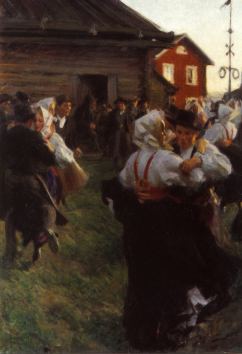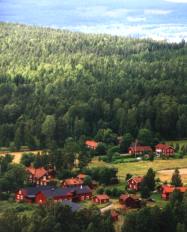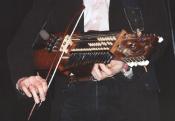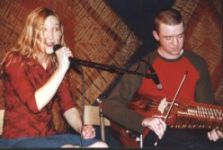FolkWorld article by Michael Moll:
A trip to Dalarna
Scanfolk Part V: A folk revival by a painter, red horses and - folk music!
 Dalarna,
a region in the centre of Sweden, is today seen by most people as the "typical",
the romantic Sweden. Dalarna's houses in the "Falun" red colour in
a landscape with forests, big lakes and hills; then the wooden red horses from
Dalarna as the most famous Swedish souvenir, and of course the folk music as
well as the Midsummer Dance traditions which are supposed to be strongest in
Dalarna. This is the image, and coming to Dalarna, all of this can be found
- partly in a touristic-kitschy way, partly also just wonderful. From the folk
music side of things, the most famous event of Dalarna (and of Sweden) is definitely
the Falun Folk Festival.
Dalarna,
a region in the centre of Sweden, is today seen by most people as the "typical",
the romantic Sweden. Dalarna's houses in the "Falun" red colour in
a landscape with forests, big lakes and hills; then the wooden red horses from
Dalarna as the most famous Swedish souvenir, and of course the folk music as
well as the Midsummer Dance traditions which are supposed to be strongest in
Dalarna. This is the image, and coming to Dalarna, all of this can be found
- partly in a touristic-kitschy way, partly also just wonderful. From the folk
music side of things, the most famous event of Dalarna (and of Sweden) is definitely
the Falun Folk Festival.
Dalarna is also home of Sweden's most famous, and probably also best, painter:
Anders Zorn (1860-1920), a fascinating character. Zorn is best known for his
beautiful paintings of nude ladies outdoors, as well as scenes of the traditional
life in Mora. His most famous painting is "Midsummer dance". These
days, the Midsummer Celebrations typically involve traditional dances around
a maypole. They have quite a magic atmosphere, as at this time of the year,
even in Dalarna the night never becomes totally dark, giving this amazing light
without shadows. These Midsummer Dances were brought back into popular culture
by among others Anders Zorn, who became very interested in the folk culture
of Dalarna. He not only bought old cottages and moved them together into a new
traditional village, but also brought people back to live a very basic traditional
life (not always in a way that would be accepted these days). And during this,
he also revived the tradition of Midsummer Dances.
Zorn is also responsible for the first Swedish folk music revival of the 20th
century. With the intention to preserve the old folk music traditions, Zorn
established a music contest in the Dalarna town of Gesunda at the lake Mora
in 1906, which resulted in a renaissance of folk music and its ultimate survival
in Sweden. Today, the Zorn Award ("Zornmärket") is still the
most prestigious price a Swedish folk musician can receive.
 The
Gesunda musicians meeting was maybe the first of the gatherings of traditional
musicians; today there are probably hunderes of the so called "spelmansstämmor"
around Sweden. These Spelmansstämmor are festivals where traditional musicians,
singers and dancers come together to play mainly traditional Swedish music.
The biggest of these "Stämma" happens also in Dalarna, in Bingsjö
in the parish of Rättvik. Obviously, the main instrument you will come
across on these events is the fiddle, being the national Swedish instrument,
along with the Swedish nyckelharpa and other traditional and not-so-traditional
instruments.
The
Gesunda musicians meeting was maybe the first of the gatherings of traditional
musicians; today there are probably hunderes of the so called "spelmansstämmor"
around Sweden. These Spelmansstämmor are festivals where traditional musicians,
singers and dancers come together to play mainly traditional Swedish music.
The biggest of these "Stämma" happens also in Dalarna, in Bingsjö
in the parish of Rättvik. Obviously, the main instrument you will come
across on these events is the fiddle, being the national Swedish instrument,
along with the Swedish nyckelharpa and other traditional and not-so-traditional
instruments.
There was a second folk revival in Sweden in the middle of the 20th century,
and finally a third, slightly smaller, revival in the last one or two decades.
During this last revival, the biggest Swedish folk and world music festival
was born in 1986: The Falun Folk Festival - of course also in Dalarna. This
festival is something special in Sweden as its focus is not only on Swedish,
but also on international folk and world music. Actually this is what makes
Falun extremely refreshing after having been in Sweden for half a year: Finally
you have the opportunity again to hear something different to Swedish polskas
& co. As beautiful as Swedish music is, a bit of change is nevertheless
appreciated from time to time; this makes you also enjoy afterewards even more
again the Swedish music. (You can find somewhere in this FolkWorld issue also
a full review of the Falun Folk Festival).
When you travel in summer through Dalarna, you can find everywhere hints of
the rich folk and folk music culture of Dalarna - unfortunately often presented
in a tourist-bus-friendly way. Dalarna markets itself as a tourist destination
with these assets, and well obviously the lover of folk music might also get
enough of all this romanticised kitschy folk cliché. Being in a wonderfuly
located village with only red houses, every second of them being a hotel and
- oh what a lucky coincidence for that bus load - there is just today playing
"spontaneously" a "traditional" spelmanslag, with all of
them in their traditional costume... Not to forget all those red wooden Dalarna
horses to be found everywhere in Dalarna. -- Ah well, Dalarna is still a wonderful
place, and as in so many other places you just need to KNOW where to go to find
good quality folk music. Like at the festivals - be it Falun, the Rättvik
Folk Festival or any of those Spelmansstämma.
 There
is enough high quality folk music around in Sweden as well as in Dalrana itself
right now, and this is both the traditional way of (mainly fiddle) playing and
more innovative approaches. There is a very vibrant young scene of traditional
musicians, and you can find at a lot of festivals Swedish music workshops. With
the latest folk muisc revival, the general recognition of folk music has mounted
immensely: You can study now folk music at the Royal Music Academy the government
(and all political parties) recognise traditional music as an important asset
in Swedish culture. Falun Festival has brought also quite a recognition of folk
music among younger people.
There
is enough high quality folk music around in Sweden as well as in Dalrana itself
right now, and this is both the traditional way of (mainly fiddle) playing and
more innovative approaches. There is a very vibrant young scene of traditional
musicians, and you can find at a lot of festivals Swedish music workshops. With
the latest folk muisc revival, the general recognition of folk music has mounted
immensely: You can study now folk music at the Royal Music Academy the government
(and all political parties) recognise traditional music as an important asset
in Swedish culture. Falun Festival has brought also quite a recognition of folk
music among younger people.
 As
much as folk music is rooted these days again in the popular Swedish culture,
still, folk music is a minority thing. Concerts are even in the capital intimate
affairs where "normal" people would usually not go to. I think one
reason for the fact that folk music does not become a more mainstream interest
is the general lack of variety - even Stockholm offers in the folk music sector
nearly only Swedish folk concerts and dances (with the odd guests from Finland).
As
much as folk music is rooted these days again in the popular Swedish culture,
still, folk music is a minority thing. Concerts are even in the capital intimate
affairs where "normal" people would usually not go to. I think one
reason for the fact that folk music does not become a more mainstream interest
is the general lack of variety - even Stockholm offers in the folk music sector
nearly only Swedish folk concerts and dances (with the odd guests from Finland).
This is the final part of the Scanfolk series, as I have left Scandinavia by
now. I have discovered during my Scandinavian year plenty of great Scandinavian
music, and I was impressed by the different handling of folk music, being in
both Denmark and Sweden well funded by the state. I fell in love with the countries,
and I am missing the beautiful sceneries as well as Stockholm, the most wonderful
capital in the world. And I also miss the Swedish music.
There is enough talent out there that still needs to be discovered by the folk
scene in the rest of Europe.
Further Reading and Info on the Swedish Folk Music Scene:
The first three parts of the Scanfolk series:
Photo & Picture Credit:
Painting: Anders Zorn: Midsummer Dance, 1896, exhibited in the Nationalmuseum
Stockholm
Photos by the Mollis:
(1) Dalarna: Forest and red houses (2) A Nyckelharpa (3) Ranarim's Ulrika Bodén
& Niklas Roswall
Back to the content of FolkWorld
Articles, Live Reviews & Columns
To the content of FolkWorld
online magazine Nr. 20
© The Mollis - Editors
of FolkWorld; Published 12/2001
All material published in FolkWorld is © The Author via FolkWorld. Storage for private use is allowed and welcome. Reviews and extracts of up to 200 words may be freely quoted and reproduced, if source and author are acknowledged. For any other reproduction please ask the Editors for permission.
FolkWorld - Home of European Music

Layout & Idea of FolkWorld © The Mollis - Editors of FolkWorld
 Dalarna,
a region in the centre of Sweden, is today seen by most people as the "typical",
the romantic Sweden. Dalarna's houses in the "Falun" red colour in
a landscape with forests, big lakes and hills; then the wooden red horses from
Dalarna as the most famous Swedish souvenir, and of course the folk music as
well as the Midsummer Dance traditions which are supposed to be strongest in
Dalarna. This is the image, and coming to Dalarna, all of this can be found
- partly in a touristic-kitschy way, partly also just wonderful. From the folk
music side of things, the most famous event of Dalarna (and of Sweden) is definitely
the Falun Folk Festival.
Dalarna,
a region in the centre of Sweden, is today seen by most people as the "typical",
the romantic Sweden. Dalarna's houses in the "Falun" red colour in
a landscape with forests, big lakes and hills; then the wooden red horses from
Dalarna as the most famous Swedish souvenir, and of course the folk music as
well as the Midsummer Dance traditions which are supposed to be strongest in
Dalarna. This is the image, and coming to Dalarna, all of this can be found
- partly in a touristic-kitschy way, partly also just wonderful. From the folk
music side of things, the most famous event of Dalarna (and of Sweden) is definitely
the Falun Folk Festival. The
Gesunda musicians meeting was maybe the first of the gatherings of traditional
musicians; today there are probably hunderes of the so called "spelmansstämmor"
around Sweden. These Spelmansstämmor are festivals where traditional musicians,
singers and dancers come together to play mainly traditional Swedish music.
The biggest of these "Stämma" happens also in Dalarna, in Bingsjö
in the parish of Rättvik. Obviously, the main instrument you will come
across on these events is the fiddle, being the national Swedish instrument,
along with the Swedish nyckelharpa and other traditional and not-so-traditional
instruments.
The
Gesunda musicians meeting was maybe the first of the gatherings of traditional
musicians; today there are probably hunderes of the so called "spelmansstämmor"
around Sweden. These Spelmansstämmor are festivals where traditional musicians,
singers and dancers come together to play mainly traditional Swedish music.
The biggest of these "Stämma" happens also in Dalarna, in Bingsjö
in the parish of Rättvik. Obviously, the main instrument you will come
across on these events is the fiddle, being the national Swedish instrument,
along with the Swedish nyckelharpa and other traditional and not-so-traditional
instruments.  There
is enough high quality folk music around in Sweden as well as in Dalrana itself
right now, and this is both the traditional way of (mainly fiddle) playing and
more innovative approaches. There is a very vibrant young scene of traditional
musicians, and you can find at a lot of festivals Swedish music workshops. With
the latest folk muisc revival, the general recognition of folk music has mounted
immensely: You can study now folk music at the Royal Music Academy the government
(and all political parties) recognise traditional music as an important asset
in Swedish culture. Falun Festival has brought also quite a recognition of folk
music among younger people.
There
is enough high quality folk music around in Sweden as well as in Dalrana itself
right now, and this is both the traditional way of (mainly fiddle) playing and
more innovative approaches. There is a very vibrant young scene of traditional
musicians, and you can find at a lot of festivals Swedish music workshops. With
the latest folk muisc revival, the general recognition of folk music has mounted
immensely: You can study now folk music at the Royal Music Academy the government
(and all political parties) recognise traditional music as an important asset
in Swedish culture. Falun Festival has brought also quite a recognition of folk
music among younger people. As
much as folk music is rooted these days again in the popular Swedish culture,
still, folk music is a minority thing. Concerts are even in the capital intimate
affairs where "normal" people would usually not go to. I think one
reason for the fact that folk music does not become a more mainstream interest
is the general lack of variety - even Stockholm offers in the folk music sector
nearly only Swedish folk concerts and dances (with the odd guests from Finland).
As
much as folk music is rooted these days again in the popular Swedish culture,
still, folk music is a minority thing. Concerts are even in the capital intimate
affairs where "normal" people would usually not go to. I think one
reason for the fact that folk music does not become a more mainstream interest
is the general lack of variety - even Stockholm offers in the folk music sector
nearly only Swedish folk concerts and dances (with the odd guests from Finland).
